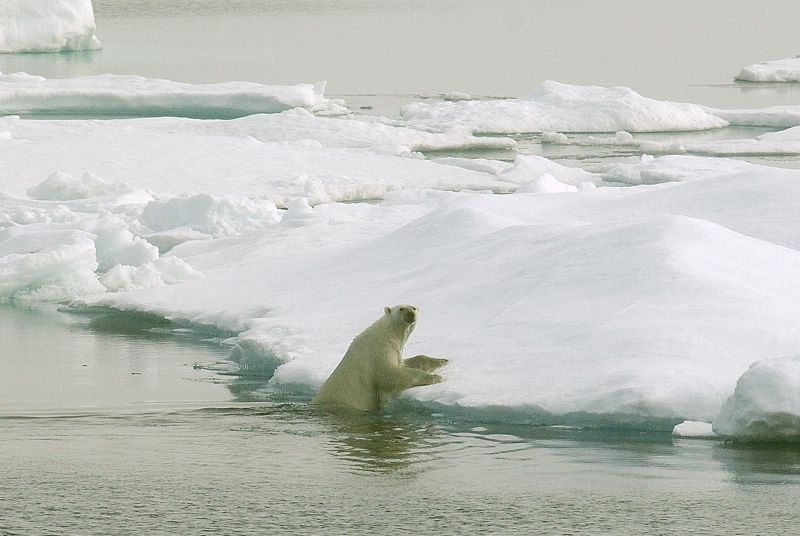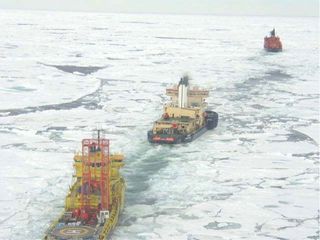
Year-Round Arctic Ice Cooled Earth Earlier Than Thought

The Arctic Ocean had an icy head start on Antarctica as the Earth cooled down after an extreme warm spell about 55 million years ago, a new study finds.
For decades, scientists have thought that Antarctica froze before the Arctic Ocean saw its first perennial sea ice, which is ice that lasts through the summer. Antarctica started icing over about 34 million years ago, according to geologic evidence left behind by glaciers. Until now, evidence for perennial sea ice in the Arctic was just 18 million years old.
But a sediment core drilled from the Arctic seafloor — the first-ever Arctic core for the international ocean drilling program — now rewrites that race to refrigerate the poles. The Arctic Ocean was frozen through summer by 36.7 million years ago, according to a study published yesterday (Jan. 26) in the journal Nature Geoscience. And with year-round ice reflecting the sun and chilling the ocean, the Arctic may have cooled the planet, the authors suggest.
"This tells us the Arctic Ocean may have played a major role in causing climate to change," said Dennis Darby, a geological oceanographer at Old Dominion University in Virginia and lead study author. "The perennial ice in the Arctic cools everything. The Arctic Ocean is our global air conditioner for the whole Earth." [10 Things You Need to Know About Arctic Sea Ice]
Grain by grain
Darby and his colleagues tracked ancient Arctic sea ice with small grains of an iron mineral called magnetite. Too big and heavy to be carried by wind or ocean currents, the researchers think. Rather, the magnetite fragments were caught in ice that formed near the coastline and then carried by the ice out to sea, freed by melting and dropped to the seafloor. Magnetite contains unique geochemical tracers that can be linked to rocks onshore, and Darby has spent two decades compiling a database of nearly 40,000 samples of Arctic magnetite sources.

Darby said that it would take at least a year, even with the sea ice drifting in a straight line, for sea ice to traverse the distance from the magnetite source to the drilling site. Today, Arctic sea ice travels a circular path around the ocean basin. This means the Arctic sea ice must have stuck around through summer, the researchers reported.
Sign up for the Live Science daily newsletter now
Get the world’s most fascinating discoveries delivered straight to your inbox.
The first signs of perennial sea ice popped up in the sediment core about 44 million years ago, according to the study. The core's sediments extend back to about 50 million years ago, Darby said. But the summer ice appears intermittently until 36.7 million years ago, when the iron grains indicate there was permanent, year-round ice in the Arctic Ocean, the study finds. The year-round ice lasted until about 6 million years ago, when the Strait of Gibraltar closed and the Mediterranean Sea was cut off from the Atlantic Ocean. This temporarily shifted the Atlantic Ocean's currents.
Then, "in the last million years, we get into the glacial world we know today," Darby said.
Perennial ice problems
While the new study is a step forward in understanding the timeline of the Arctic Ocean's ice cap, many questions still remain about why and how the perennial ice appeared.
"What we don't understand is what actually precipitated the perennial ice in the Arctic," Darby told LiveScience. "There were no major drops in temperature at 36.7 million years [ago], nothing that indicates why. We can only speculate that all it takes is some cooler summers."
Further work could help researchers better understand the future of perennial Arctic sea ice, now predicted to disappear completely by 2100. (There will still be seasonal, or winter sea ice.)
For example, seasonal or perennial ice may have persisted in the Arctic during a brief but extreme warming in the Arctic about 40 million years ago, when global ocean temperatures rose about 9 degrees Fahrenheit (5 degrees Celsius).
"The perennial ice will probably disappear in the next 50 years," Darby said. "My data shows that this ice will probably come back. The real problem we have is, we don't know under what conditions it will come back or how quickly."
Email Becky Oskin or follow her @beckyoskin. Follow us @livescience, Facebook & Google+. Original article on LiveScience.












